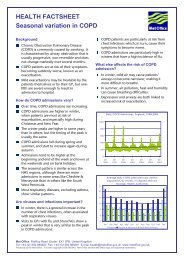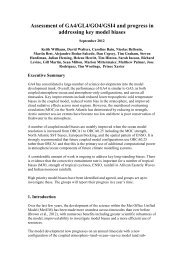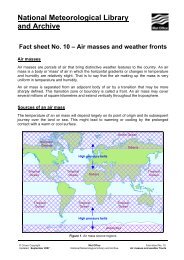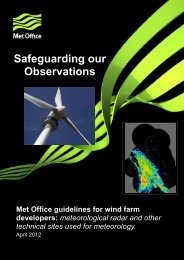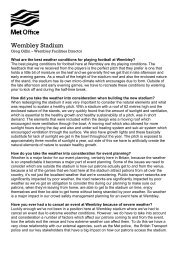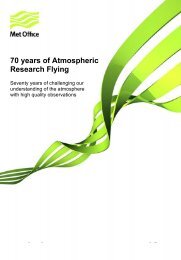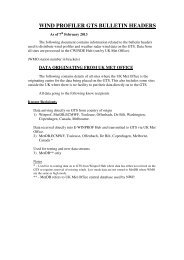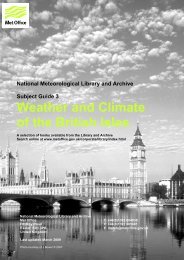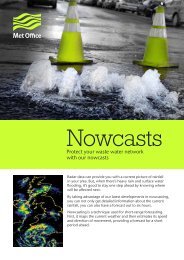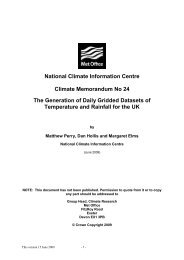Description and assessment of the OSTIA reanalysis. - Met Office
Description and assessment of the OSTIA reanalysis. - Met Office
Description and assessment of the OSTIA reanalysis. - Met Office
You also want an ePaper? Increase the reach of your titles
YUMPU automatically turns print PDFs into web optimized ePapers that Google loves.
The dataset has provided input to many climate products <strong>and</strong> research applications <strong>and</strong> has been<br />
used in previous <strong>reanalysis</strong> products as <strong>the</strong> (or a significant part <strong>of</strong>) reference dataset for <strong>the</strong> ocean<br />
surface (Worley et al., 2005; Woodruff et al., 2010, <strong>and</strong> references <strong>the</strong>rein). Thus <strong>the</strong> dataset is<br />
ideal for use as a reference for <strong>the</strong> <strong>OSTIA</strong> <strong>reanalysis</strong>.<br />
The ICOADS QC (quality control) procedure includes consistency checks, checks against climatologies,<br />
trimming <strong>of</strong> outliers, position errors against a l<strong>and</strong>-sea mask <strong>and</strong> addition <strong>of</strong> QC flags to<br />
<strong>the</strong> record (Worley et al., 2005). Additional QC was performed by <strong>the</strong> UK <strong>Met</strong> <strong>Office</strong> Hadley Centre,<br />
comprising <strong>of</strong> basic QC checks for valid date, time <strong>and</strong> position, a day/night check based on <strong>the</strong><br />
solar zenith angle, a positional QC ship track check, a comparison to climatology, a freezing check<br />
<strong>and</strong> a buddy comparison with o<strong>the</strong>r nearby observations. Before inclusion in <strong>the</strong> <strong>OSTIA</strong> <strong>reanalysis</strong><br />
<strong>the</strong> data also underwent a maximum <strong>and</strong> minimum temperature check <strong>and</strong> a background check<br />
using <strong>the</strong> previous day’s analysis.<br />
Each ICOADS release has been developed incrementally from previous releases <strong>and</strong> has been<br />
successively improved since <strong>the</strong> release <strong>of</strong> <strong>the</strong> initial version in 1985 (Worley et al., 2005). Although<br />
Release 2.5 is <strong>the</strong> most recent version at <strong>the</strong> time <strong>of</strong> writing, a version <strong>of</strong> Release 2.1, updated<br />
from 1998 by <strong>the</strong> UK <strong>Met</strong> <strong>Office</strong> Hadley Centre using NCEP GTS data, was used for <strong>the</strong> <strong>OSTIA</strong><br />
<strong>reanalysis</strong> as this was <strong>the</strong> most recent version to have undergone <strong>the</strong> full QC procedures.<br />
To produce <strong>the</strong> best possible set <strong>of</strong> observations a complex <strong>and</strong> robust blending <strong>and</strong> duplicate<br />
elimination process is used in ICOADS to remove overlaps <strong>and</strong> duplication <strong>of</strong> observations between<br />
some <strong>of</strong> <strong>the</strong> sources, as well as to correct issues such as new versions <strong>of</strong> datasets which only<br />
partially replace older versions, <strong>and</strong> where some parts <strong>of</strong> sources are <strong>of</strong> inferior quality (Worley<br />
et al., 2005; Woodruff et al., 2010). ICOADS does not include adjustments to account for observing<br />
system changes (e.g. instrumentation, sampling procedures <strong>and</strong> measurement coding changes) or<br />
measurement biases (Worley et al., 2005). However, in comparison with <strong>the</strong> variation in observation<br />
methods across <strong>the</strong> entire ICOADS Release 2.1 dataset (from 1784), heterogeneities in observing<br />
systems during <strong>the</strong> <strong>OSTIA</strong> <strong>reanalysis</strong> period <strong>of</strong> 1985-2007 are small. In addition, owing to denser,<br />
more accurate sampling, <strong>the</strong> uncertainties in <strong>the</strong> dataset should decrease closer to near-current<br />
dates (Worley et al., 2005).<br />
Figure 2.5 shows <strong>the</strong> number <strong>of</strong> nighttime in-situ observations used in <strong>the</strong> <strong>reanalysis</strong> throughout<br />
<strong>the</strong> period. In order to produce <strong>the</strong> foundation SST, nighttime data only were used for <strong>the</strong> <strong>OSTIA</strong><br />
<strong>reanalysis</strong>. For ICOADS, this is set by <strong>the</strong> solar zenith angle. If <strong>the</strong> sun was above <strong>the</strong> horizon one<br />
hour previous to <strong>the</strong> measurement time, <strong>the</strong> observation is classified as daytime <strong>and</strong> is not used.<br />
The number <strong>of</strong> ship-based observations has decreased over time (figure 2.5) while <strong>the</strong> contributions<br />
from moored <strong>and</strong> drifting buoys have increased, particularly rapidly for drifters from <strong>the</strong> mid-1990s<br />
onwards. The step increase in <strong>the</strong> number <strong>of</strong> drifter observations in 2005 is possibly due to an<br />
increase in <strong>the</strong> frequency <strong>of</strong> reporting times as well as a potential increase in <strong>the</strong> number <strong>of</strong> drifters<br />
<strong>the</strong>mselves. As noted by Woodruff et al. (2010), each observing platform has its advantages. VOS<br />
(Voluntary Observing Ships) provide regular sampling along <strong>the</strong> major shipping routes <strong>and</strong> research<br />
© c Crown Copyright 2011 19




